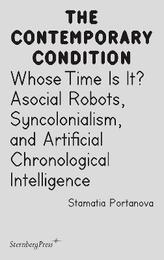
|
Whose Time Is It?: Asocial Robots, Syncholonialism, and Artificial Chronological Intelligence
Paperback / softback
Main Details
| Title |
Whose Time Is It?: Asocial Robots, Syncholonialism, and Artificial Chronological Intelligence
|
| Authors and Contributors |
By (author) Stamatia Portanova
|
| Series | Sternberg Press / The Contemporary Condition |
|---|
| Physical Properties |
| Format:Paperback / softback | | Pages:104 | | Dimensions(mm): Height 191,Width 119 |
|
| Category/Genre | The arts - general issues
Artificial intelligence |
|---|
| ISBN/Barcode |
9783956796081
|
| Classifications | Dewey:006.301 |
|---|
| Audience | |
|---|
|
Publishing Details |
| Publisher |
Sternberg Press
|
| Imprint |
Sternberg Press
|
| Publication Date |
1 February 2022 |
| Publication Country |
United States
|
Description
Following the "emerging life adventures and experiences" of Sophia, a robot animated by blockchain and AI, to present a study in temporal automation. In what way do the two technologies of blockchain and artificial intelligence actualize and, crucially, automatize the cognition of time? These kinds of machines are increasingly part of both our contemporary present and our prospective future, but how do we really define a present and a future? And more important, how do these machines themselves understand, know, and sense time? Can machines really think about the present and dream the future in an autonomous way? In order to unravel these questions, Whose Time Is It? follows the "emerging life adventures and experiences" of Sophia, a robot animated by blockchain and AI, to present a study in temporal automation.
Author Biography
Stamatia Portanova is Research Fellow at the Department of Human and Social Sciences, Universit degli Studi di Napoli "L'Orientale" (Naples). She is also a member of the Technoculture Research Unit. Her research focuses on digital culture and philosophy. She is the author of Moving without a Body- Digital Philosophy and Choreographic Thoughts (MIT Press), and has published articles in AI & Society, Body & Society, Computational Culture, Space and Culture, Fibreculture Journal, and Angelaki.
|